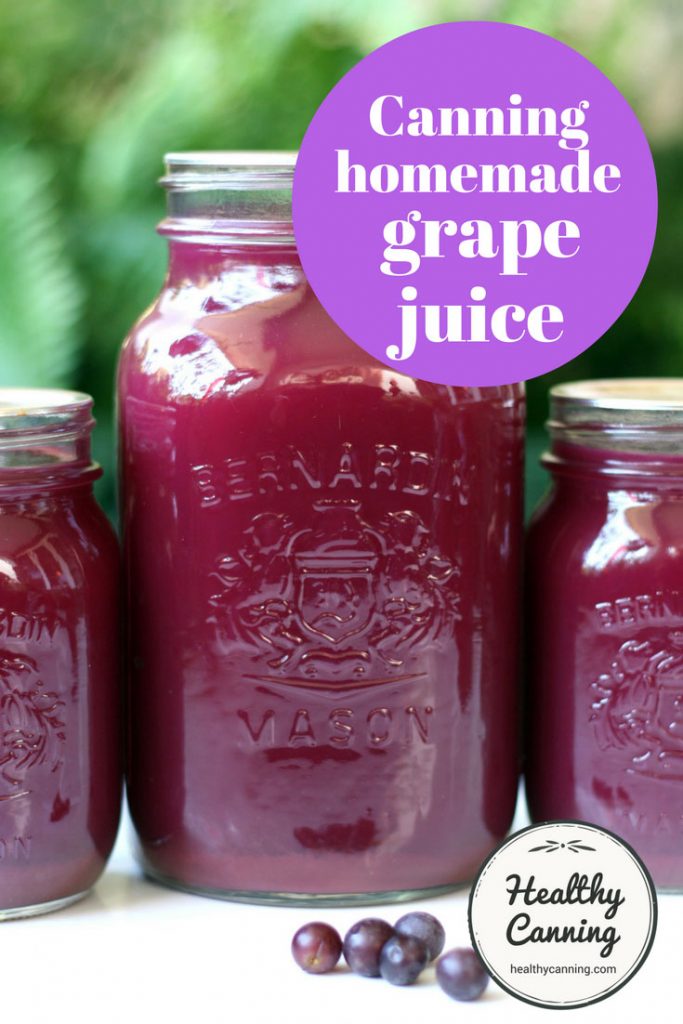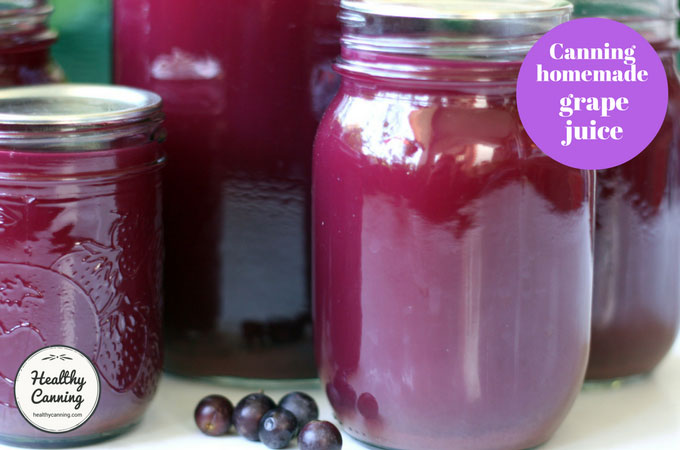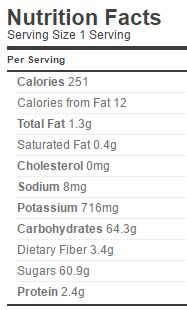
Grape juice made from muscadine grapes. 2 litre / 2 US quart jar in centre.
Home-canned grape juice is delicious and tastes nothing like the store bought. You can sweeten it to taste.
You can home-can grape juice in jar sizes ranging from a pint to 2 quarts (half-litre to 2 litres).
If you go for the larger jar size, make sure to store the jars on very sturdy shelving.
There are two methods: one crushes the grapes to extra more juice. The other does not, aiming instead for a clearer juice. See “Crushing the grapes” note.
Quantities of grapes needed
Numbers are approximate guidelines.
On average, as a very rough guideline, expect to need about 1.5 kg (3.5 lbs) of grapes per 1 litre (US quart) jar of canned grape juice
11 kg (24.5 lb.) of grapes = 7 litres (US quarts) canned grape juice
7 kg (16 lbs.) of grapes = 9 x half-litres (US pints) canned grape juice
1 lug grapes = 12 kg (26 lbs.) = 7 to 9 litres (US quarts) canned grape juice
The recipe
Jar size choices: Either half-litre (1 US pint) OR 1 litre (1 US quart) OR 2 litre (2 US quart / US half-gallon)
Processing method: Water bath or steam canning
Yield: varies
Headspace: 1 cm (¼ inch)
Processing time: Half-litres and litres (US pints and US quarts) 5 minutes; 2 litres (2 US quarts / US half-gallon) 10 minutes

Grape Juice
Instructions
- Wash and stem grapes.
- Put grapes in sauce pan.
- Crush with potato masher or similar device. (See 'Crushing the grapes' note below)
- If there's not enough juice to cover the crushed grapes, add just enough boiling water from a kettle to cover the grapes.
- Heat pot to a boil, then lower to a simmer and simmer uncovered for 10 minutes, until the grape skins are soft.
- Strain through either a double-layer of cheese cloth, or a jelly bag.
- Discard skins and sediment.
- Put juice in covered containers in the refrigerator and let stand there for 24 to 48 hours.
- Carefully pour juice into a pot, being careful not to disturb the sediment at the bottom of the containers.
- Discard sediment.
- Taste the juice cold, see if you want to sweeten it.
- If so, do so now to taste.
- Heat juice, stirring occasionally, until it comes to a boil.
- Ladle hot juice into jars. (See note on special jar sterilization.)
- Leave 1 cm (¼ inch) headspace.
- Wipe jar rims.
- Put lids on.
- Process in a water bath or steam canner.
- The processing time is 5 minutes for half-litres and litres (US pints and US quarts); 10 minutes for 2 litre (2 quart / US half-gallon) jars. Increase time as needed for your altitude.
Nutrition
Reference information
How to water bath process.
How to steam can.
When water-bath canning or steam canning, you must adjust the processing time for your altitude.
For stevia, Better Stevia liquid stevia was the stevia used.
What is the shelf life of home canned goods?
Jar sterilization
If you will be processing the juice for 5 minutes (as you will for the half-litres and litres / US pints and US quarts), you must sterilize the jars first.
Alternatively, simply increase the processing time to 10 minutes for these two jar sizes. This negates the need for jar sterilization because the rule for home canning is that anything being processed 10 minutes or over (or pressure canned) does not need its jar sterilized: the processing time will look after that.
Special jar size note
Home-canned grape juice is one of only two recommended uses for the 2 litre / 2 US quart jars in home canning. The other use is apple juice.
Crushing the grapes: yes or no?
The USDA Complete Guide and the Ball / Bernardin Complete have you crush the grapes. This is the step we give above.
Some people prefer NOT to crush the grapes as it feels it gives a cloudiness to the juice that no amount of straining can fix.
So Easy to Preserve omits the crushing step, saying:
“Wash and stem grapes. Place grapes in a saucepan and add boiling water to cover grapes. Heat and simmer slowly until skins are soft. Strain through a damp jelly bag or double layers of cheesecloth. Refrigerate juice for 24 to 48 hours. Without mixing, carefully pour off and save clear liquid. Discard sediment. If desired, strain for a paper coffee filter for a clearer juice. Place juice in a saucepan. Sweeten juice to taste, if desired. Heat, stirring until juice begins to boil. Pour into hot jars, leaving ¼ inch headspace. Wipe jar rims. Adjust lids. Process in a boiling water bath. Pints or quarts 5 minutes, half-gallons 10 minutes.”
Recipe notes
- If you don’t have a potato masher, you possibly could chop in a food processor and put into pot, because while an electric blade is damaging to pectin, we don’t care about pectin here.
- When you are pouring the chilled grape juice into a pot, if you wish you may strain it a second time through a coffee filter for a clearer juice but note that this can be an extremely slow process that takes hours.
- Letting the juice stand in the fridge serves a few purposes. It allows sediment to settle, and, it deals with “tartrate crystals” : “During storage white crystals often form in the bottom of the jar. They are tartrate crystals and are harmless. However, you can prevent tartrate crystals by allowing the prepared juice to stand 24 to 48 hours in the refrigerator.” [1]Grapes and Grape Juice. Penn State Extension. 23 August 2012. Accessed Sept 2016.
- When you are reheating the juice for canning, Penn State Extension emphasizes why you want to fully reheat it: “Occasionally grape juice will ferment. This is likely the result of yeasts that were not killed during heating and processing. Grapes are high in yeasts and the peel is not removed as in some fruit. The processing of grape juice is only killing organisms in the headspace and providing a firm seal. Heating the juice adequately before pouring it into the jar is essential for destroying microorganisms.” [2]Ibid.
- Yes, you have to remove the stems before starting, or it will adversely affect the taste of the juice: “Initially, the stem (or stalk) is removed due to the large amount of tannins contained within.” [3]Kyle Dwyer, Farah Hosseinian, & Michel Rod. Market Potential of Grape Waste Alternatives. Journal of Food Research; Vol. 3, No. 2; 2014. Page 92.
- If you want to sweeten the juice and are using liquid stevia to sweeten, try about 1 to 1.5 teaspoons per litre / US quart for sweetening.

Grape juice made from muscadine grapes
Recipe source
- United States Department of Agriculture (USDA). Complete guide to home canning. Agriculture information bulletin No. 539. 2015. Page 2-15.
- Andress, Elizabeth L. and Judy A. Harrison. So Easy to Preserve. University of Georgia Cooperative Extension. Bulletin 989. Sixth Edition. 2014. Page 45.
- Kingry, Judi and Lauren Devine. Ball / Bernardin Complete Book of Home Preserving. Toronto: Robert Rose. 2015. Page 190.
Modifications made:
- none
Nutrition information
Per 1 cup (250 ml / 8 oz), no sugar added
- 251 calories, 8 mg sodium
* Nutrition info provided by https://caloriecount.about.com

2 litre / quart jar (R); half-litre / pint jar (L)
References


Tiffany
My daughter loves this juice!! Great recipe! Thank you!
Beth Ann Schad
Could I feasibly use this recipe for other fruits to turn them into juice?
Healthy Canning
Here is a pamphlet from Oregon State Extension Service on making and home canning juices.
Kim
I just found juice that I canned 5 years ago, hidden in the basement. There’s very little sediment in the bottom of the quart jars. Should I try it? Maybe refrigerate and reheat and just drink right away? Would love your thoughts. I stumbled on your site, while asking google how long canned juice would last.
Healthy Canning
See: https://www.healthycanning.com/the-shelf-life-of-home-canned-goods
Rachel Johnson
My test is always to open, smell and look for signs of spoilage inside the jar or inside of the lid. It should still be good after 5 years if it is sealed.
Samantha
How long can the grape juice be kept? How long is it shelf stable after canning?
Will be picking our grapes this week.
Thanks for the recipe!
Healthy Canning
See shelf life: https://www.healthycanning.com/the-shelf-life-of-home-canned-goods/
Donna Fillie
I wonder if I can get a response to this question. I had more grapes last fall then we could use. My cupboard if still full of jelly The grapes were cleaned and processed into very clear juice and I carefully froze bags of it. Is it alright to can this as juice? No sugar has been added to the frozen product. Thank you. I can’t find answers on the internet anywhere to this question .
Healthy Canning
Yes, it would be fine to thaw and can that as juice. It’s fine to use the freezer as a temporary “holding tank” for many things until time for canning presents itself!